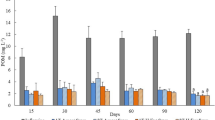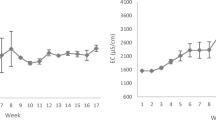Abstract
The feasibility of using fish farm effluents was evaluated as a source of inorganic nutrients for mass production of marine diatoms. Batch cultures were conducted from May to July 1995 in 16-L outdoor rectangular tanks, homogenized by gentle aeration (0.2 L air L−1 h−1). The effluents from the two fish farms studied were both characterized by high concentrations of inorganic materials (NH4-N, PO4-;P, Si(OH)4-Si) and were shown to support production of marine diatoms. Moreover, periodic measurements of inorganic matter levels in the cultures showed that clearance was efficacious (90% in 3–5 days). Water purification efficiency and culture productivity were further increased through appropriate nutrient balancing. When effluents were limited in silicate, addition of Na2SiO3 induced a significant increase in both diatom biomass and nutrient removal efficiency. In this case, up to 720 000 cell mL−1 were produced dominated bySkeletonema costatum. By contrast, in effluents loaded with silicate, adjustment of the N:P:Si ratio by NH4-N and PO4-P supplementation then gave increased biomass production. In this case, the maximum cell density found was 450 000 cell mL−1, dominated byChaetoceros spp.
Similar content being viewed by others
References
Aminot A, Chaussepied M (1983) Manuel des Analyses Chimiques en Milieu Marin. CNEXO, Brest, 394 pp.
Baud JP, Bacher C (1990) Use of saline ground water for intensive rearing ofRuditapes philippinarum juveniles in a nursery system. Aquaculture 88: 157–178.
Boyd CE (1995) Source water, soil, and water quality impacts on sustainability in aquaculture. Sustainable Aquaculture '95. Pacon International, Hawaii: 24–33.
Dosdat A, Servais F, Métailler R, Huelvan C, Desbruyères E (1996) Comparison of nitrogenous losses in five teleost fish species. Aquaculture 141: 107–127.
Dunstan WM, Tenore KR (1974) Control of species composition in enriched mass cultures of natural phytoplankton populations. J. appl. Ecol. 11: 529–536.
Egge JK, Aksnes DL (1992) Silicate as regulating nutrient in phytoplankton competition. Mar. Ecol. Progr. Ser. 83: 281–289.
Enright CT, Newkirk GF, Craigie JS, Castell JD (1986) Evaluation of phytoplankton as diets for juvenileOstrea edulis L. J. exp. mar. Biol. Ecol. 96: 1–13.
Eppley RW (1977) The growth and culture of diatoms. In Werner D (ed.), The Biology of Diatoms. Bot. Monograph V. 13. Blackwell, Oxford: 24–64.
Gesamp (1991) Reducing environmental impacts of coastal aquaculture. FAO Reports and Studies 47, Roma, 35 pp.
Handy RD, Poxton MG (1993) Nitrogen pollution in mariculture: toxicity and excretion of nitrogenous compounds by marine fish. Revue Fish Biol. Fish 3: 205–241.
Harrison PJ, Conway HL, Holmes RW, Davis CO (1977) Marine diatoms grown in chemostats under silicate or ammonium limitation. III. Cellular chemical composition and morphology ofChaetoceros debilis, Skeletonema costatum, andThalassiosira gravida. Mar. Biol. 43: 19–31.
Huntley M (1995) Microalgae as a source of feeds in commercial aquaculture. Sustainable Aquaculture '95. Pacon International, Hawaii: 193–204.
Hussenot J, Brossard N (1995) Premiers essais automnaux de culture en masse (24m3) de diatomées sur eau de mer fertilisée en N, P, Si. Rapports Internes de la Direction des Ressources Vivantes de l'Ifremer, n° RI-DRV 95.02, L'Houmeau (France), 48 pp.
Hussenot J, Brossard N, Lefebvre S, Martin JL (1996) Reducing the organic and nutrient loading of effluents, with a water treatment pond system, in a land-based sea-farm. World Aquaculture '96. World Aquaculture Society, Bangkok: 170.
Hussenot J, Gautier D (1994) Techniques d'utilisation de la silice pour la production de masse des algues diatomées. Synthèse des travaux 1989–1993. Rapports internes de la Direction des Ressources Vivantes de l'Ifremer, n° RI-DRV 94.03, L'Houmeau (France), 26 pp.
Hussenot J, Gautier D (1995) Production en masse de micro algues en marais sales: bases biologiques, expérimentations, applications. Aquaculture en marais-Marisma y Acuicultura. Région Poitou-Charentes-Junta de Andalucia, Le Chateau d'Oléron (France): 1–12.
Levasseur M, Thompson PA, Harrison PJ (1993) Physiological acclimatation of marine phytoplankton to different nitrogen sources. J. Phycol. 29: 587–595.
Lincoln EP, Earle JFK (1990) Wastewater treatment with microalgae. In Akatsuka I (ed.), Introduction to Applied Phycology. SPB Academic Publishing, The Hague: 429–446.
Myklestad S (1977) Production of carbohydrates by marine planktonic diatoms. II. Influence of the N/P ratio in the growth medium on the assimilation ratio, growth rate, and production of cellular and extracellular carbohydrates byChaetoceros affinis var. willei (Gran.) Hustedt andSkeletonema costatum (Grev.) Cleve. J. exp. mar. Biol. Ecol. 29: 161–179.
Rincé Y (1979). Cycle saisonnier des peuplements phytoplanctonique et microphytobenthique des claires ostreicoles de la Baie de Bourgneuf. Rev. Algol. 14: 297–313.
Roden CM, O'Mahony KW (1984) Competition as a mechanism of adaptation to environmental stress in outdoor cultures of marine diatoms. Mar. Ecol. Progr. Ser. 16: 219–227.
Shpigel M, Neori A, Popper DM, Gordin H (1993) A proposed model for ‘environmentally clean’ land-based culture of fish, bivalves and seaweeds. Aquaculture 117: 115–128.
StatITCF (1991) Manuel d'Utilisation. Institut Technique des Céréales et des Fourrages, Paris, 155 pp.
Strickland JDH, Parsons TR (1972) A Practical Handbook of Seawater Analysis, Fish. Res. Bd Can. Bull. 167, 310 pp.
Suzuki Y, Takahashi M (1995) Growth responses of several diatom species isolated from various environments to temperature. J. Phycol. 31: 880–888.
Videau C, Merceron M (1992) Impact de la pisciculture marine intensive sur l'environnement. Revue bibliographique, Ifremer, DEL. 92.13, Brest, 105 pp.
Vonshak A (1986) Laboratory techniques for the cultivation of microalgae. In Richmond A. (ed.) Handbook of Microalgal Mass Culture. CRC Press, Boca Raton: 117–145.
Author information
Authors and Affiliations
Additional information
Author for correspondence
Rights and permissions
About this article
Cite this article
Lefebvre, S., Hussenot, J. & Brossard, N. Water treatment of land-based fish farm effluents by outdoor culture of marine diatoms. J Appl Phycol 8, 193–200 (1996). https://doi.org/10.1007/BF02184971
Received:
Revised:
Accepted:
Issue Date:
DOI: https://doi.org/10.1007/BF02184971




